Locating Web Pages
VerifiedAdded on 2023/06/03
|6
|1286
|59
AI Summary
This article discusses research papers on white collar crimes and their relationship with economics and sociology. The papers explore corruption in public sector enterprises and the nuances of fraudulent practices in big businesses. The research methodologies used are qualitative and case study methods. The sources are scholarly works and official documents. The article is related to the research question as it discusses white collar crimes committed by affluent people.
Contribute Materials
Your contribution can guide someone’s learning journey. Share your
documents today.
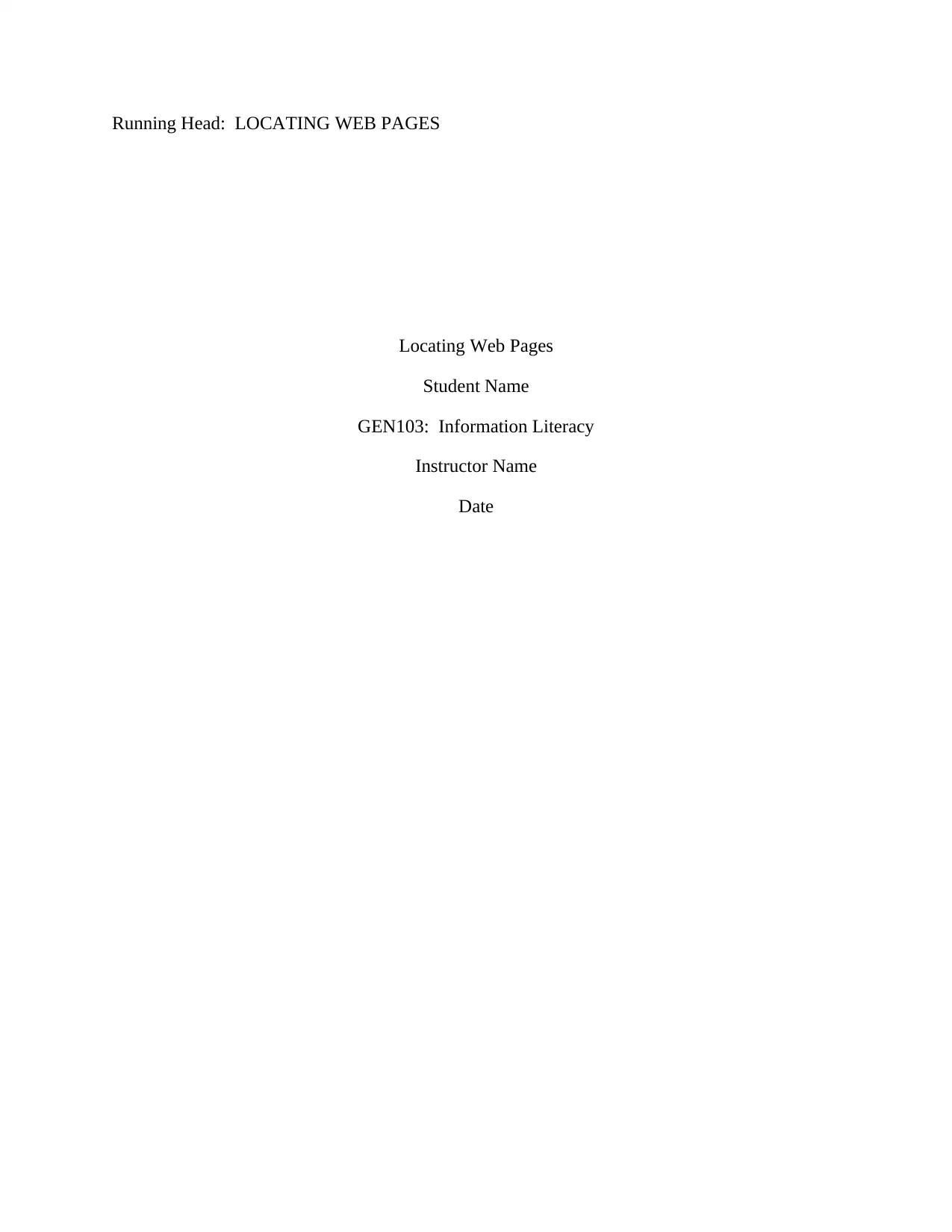
Running Head: LOCATING WEB PAGES
Locating Web Pages
Student Name
GEN103: Information Literacy
Instructor Name
Date
Locating Web Pages
Student Name
GEN103: Information Literacy
Instructor Name
Date
Secure Best Marks with AI Grader
Need help grading? Try our AI Grader for instant feedback on your assignments.
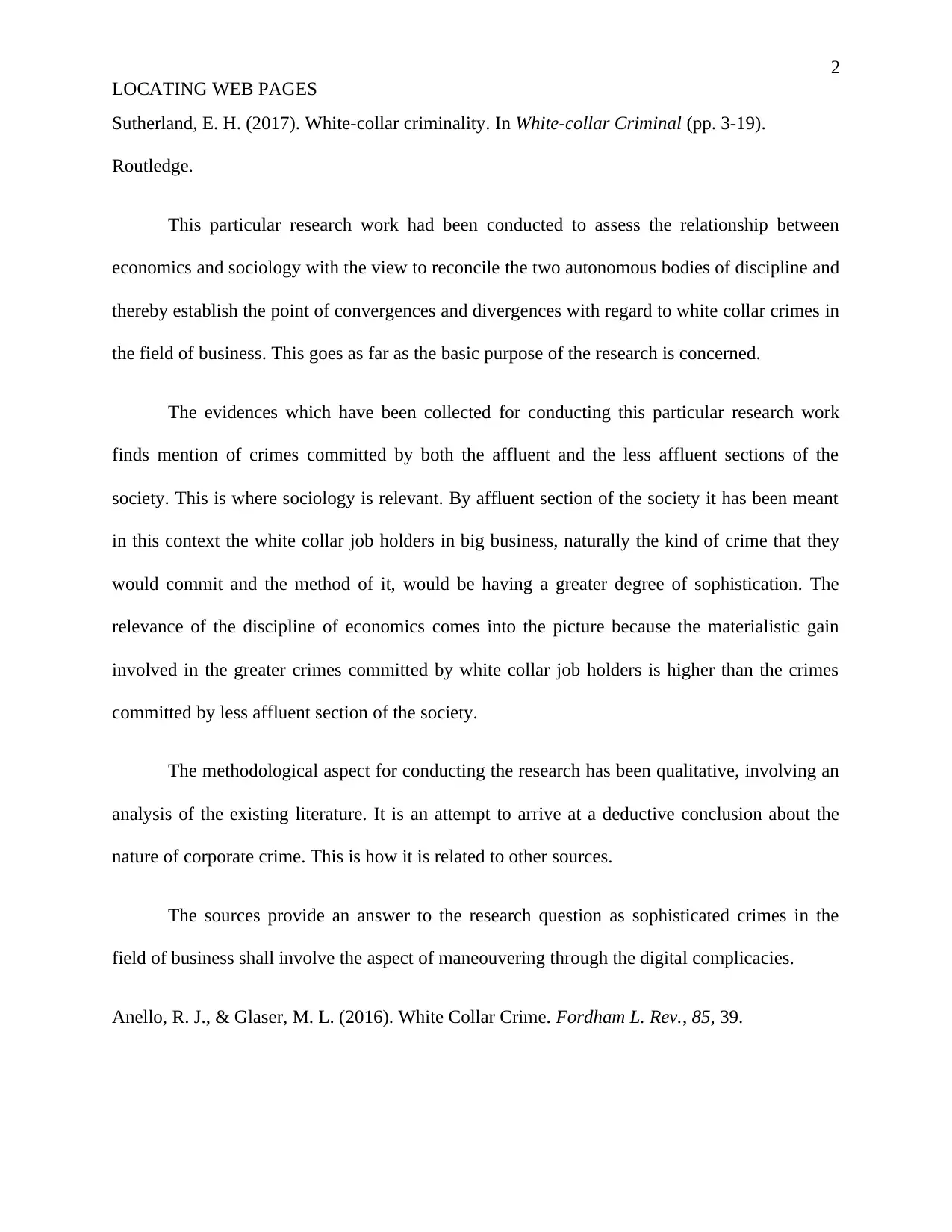
2
LOCATING WEB PAGES
Sutherland, E. H. (2017). White-collar criminality. In White-collar Criminal (pp. 3-19).
Routledge.
This particular research work had been conducted to assess the relationship between
economics and sociology with the view to reconcile the two autonomous bodies of discipline and
thereby establish the point of convergences and divergences with regard to white collar crimes in
the field of business. This goes as far as the basic purpose of the research is concerned.
The evidences which have been collected for conducting this particular research work
finds mention of crimes committed by both the affluent and the less affluent sections of the
society. This is where sociology is relevant. By affluent section of the society it has been meant
in this context the white collar job holders in big business, naturally the kind of crime that they
would commit and the method of it, would be having a greater degree of sophistication. The
relevance of the discipline of economics comes into the picture because the materialistic gain
involved in the greater crimes committed by white collar job holders is higher than the crimes
committed by less affluent section of the society.
The methodological aspect for conducting the research has been qualitative, involving an
analysis of the existing literature. It is an attempt to arrive at a deductive conclusion about the
nature of corporate crime. This is how it is related to other sources.
The sources provide an answer to the research question as sophisticated crimes in the
field of business shall involve the aspect of maneouvering through the digital complicacies.
Anello, R. J., & Glaser, M. L. (2016). White Collar Crime. Fordham L. Rev., 85, 39.
LOCATING WEB PAGES
Sutherland, E. H. (2017). White-collar criminality. In White-collar Criminal (pp. 3-19).
Routledge.
This particular research work had been conducted to assess the relationship between
economics and sociology with the view to reconcile the two autonomous bodies of discipline and
thereby establish the point of convergences and divergences with regard to white collar crimes in
the field of business. This goes as far as the basic purpose of the research is concerned.
The evidences which have been collected for conducting this particular research work
finds mention of crimes committed by both the affluent and the less affluent sections of the
society. This is where sociology is relevant. By affluent section of the society it has been meant
in this context the white collar job holders in big business, naturally the kind of crime that they
would commit and the method of it, would be having a greater degree of sophistication. The
relevance of the discipline of economics comes into the picture because the materialistic gain
involved in the greater crimes committed by white collar job holders is higher than the crimes
committed by less affluent section of the society.
The methodological aspect for conducting the research has been qualitative, involving an
analysis of the existing literature. It is an attempt to arrive at a deductive conclusion about the
nature of corporate crime. This is how it is related to other sources.
The sources provide an answer to the research question as sophisticated crimes in the
field of business shall involve the aspect of maneouvering through the digital complicacies.
Anello, R. J., & Glaser, M. L. (2016). White Collar Crime. Fordham L. Rev., 85, 39.
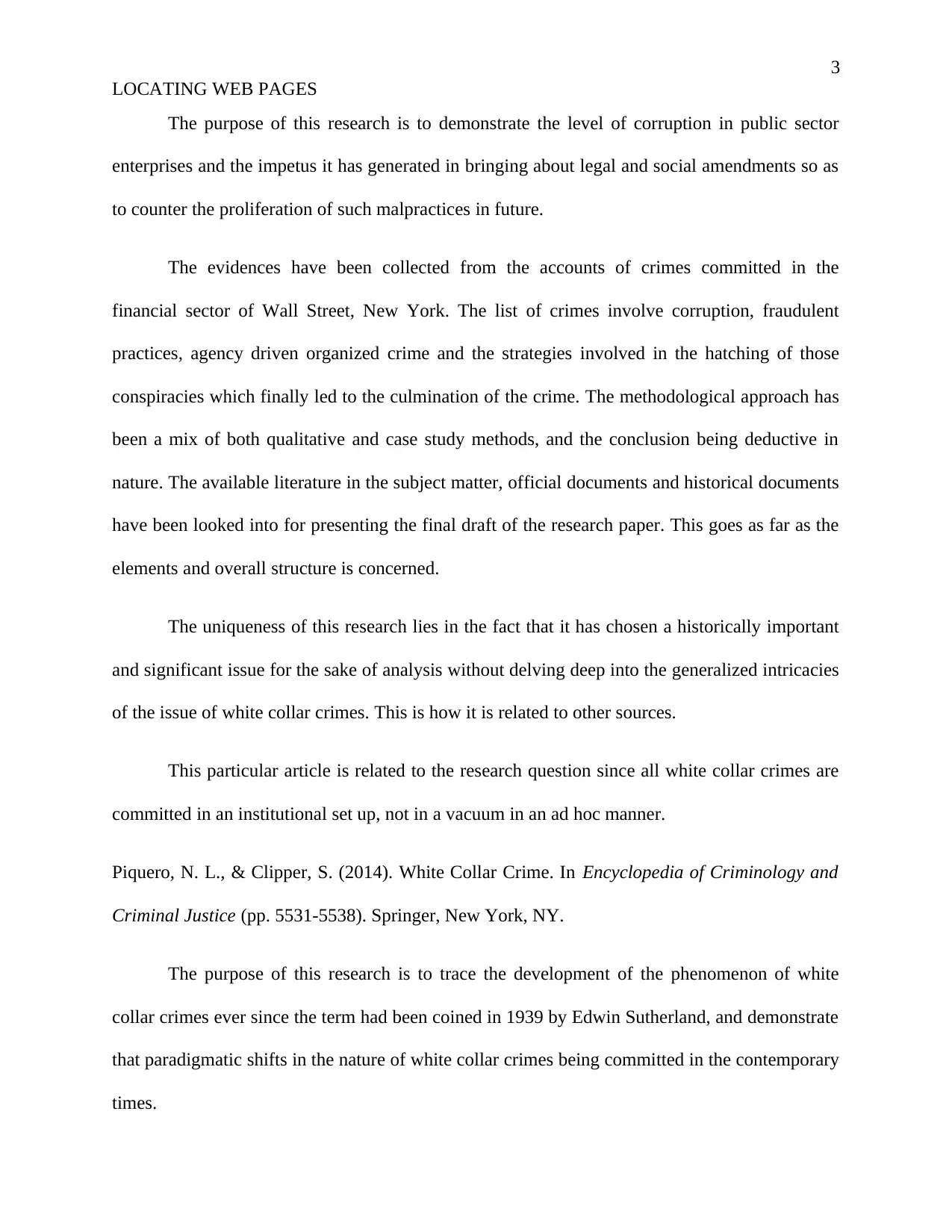
3
LOCATING WEB PAGES
The purpose of this research is to demonstrate the level of corruption in public sector
enterprises and the impetus it has generated in bringing about legal and social amendments so as
to counter the proliferation of such malpractices in future.
The evidences have been collected from the accounts of crimes committed in the
financial sector of Wall Street, New York. The list of crimes involve corruption, fraudulent
practices, agency driven organized crime and the strategies involved in the hatching of those
conspiracies which finally led to the culmination of the crime. The methodological approach has
been a mix of both qualitative and case study methods, and the conclusion being deductive in
nature. The available literature in the subject matter, official documents and historical documents
have been looked into for presenting the final draft of the research paper. This goes as far as the
elements and overall structure is concerned.
The uniqueness of this research lies in the fact that it has chosen a historically important
and significant issue for the sake of analysis without delving deep into the generalized intricacies
of the issue of white collar crimes. This is how it is related to other sources.
This particular article is related to the research question since all white collar crimes are
committed in an institutional set up, not in a vacuum in an ad hoc manner.
Piquero, N. L., & Clipper, S. (2014). White Collar Crime. In Encyclopedia of Criminology and
Criminal Justice (pp. 5531-5538). Springer, New York, NY.
The purpose of this research is to trace the development of the phenomenon of white
collar crimes ever since the term had been coined in 1939 by Edwin Sutherland, and demonstrate
that paradigmatic shifts in the nature of white collar crimes being committed in the contemporary
times.
LOCATING WEB PAGES
The purpose of this research is to demonstrate the level of corruption in public sector
enterprises and the impetus it has generated in bringing about legal and social amendments so as
to counter the proliferation of such malpractices in future.
The evidences have been collected from the accounts of crimes committed in the
financial sector of Wall Street, New York. The list of crimes involve corruption, fraudulent
practices, agency driven organized crime and the strategies involved in the hatching of those
conspiracies which finally led to the culmination of the crime. The methodological approach has
been a mix of both qualitative and case study methods, and the conclusion being deductive in
nature. The available literature in the subject matter, official documents and historical documents
have been looked into for presenting the final draft of the research paper. This goes as far as the
elements and overall structure is concerned.
The uniqueness of this research lies in the fact that it has chosen a historically important
and significant issue for the sake of analysis without delving deep into the generalized intricacies
of the issue of white collar crimes. This is how it is related to other sources.
This particular article is related to the research question since all white collar crimes are
committed in an institutional set up, not in a vacuum in an ad hoc manner.
Piquero, N. L., & Clipper, S. (2014). White Collar Crime. In Encyclopedia of Criminology and
Criminal Justice (pp. 5531-5538). Springer, New York, NY.
The purpose of this research is to trace the development of the phenomenon of white
collar crimes ever since the term had been coined in 1939 by Edwin Sutherland, and demonstrate
that paradigmatic shifts in the nature of white collar crimes being committed in the contemporary
times.
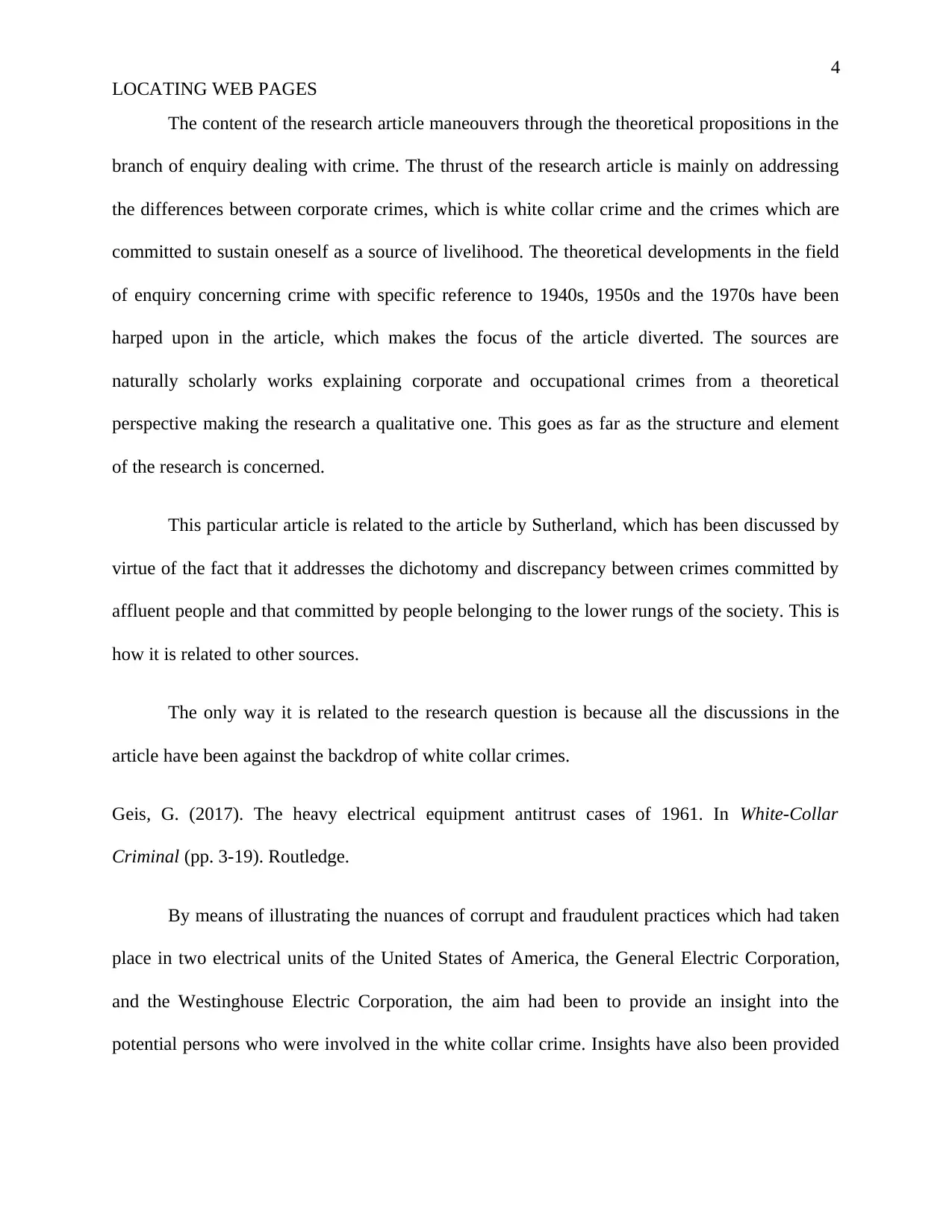
4
LOCATING WEB PAGES
The content of the research article maneouvers through the theoretical propositions in the
branch of enquiry dealing with crime. The thrust of the research article is mainly on addressing
the differences between corporate crimes, which is white collar crime and the crimes which are
committed to sustain oneself as a source of livelihood. The theoretical developments in the field
of enquiry concerning crime with specific reference to 1940s, 1950s and the 1970s have been
harped upon in the article, which makes the focus of the article diverted. The sources are
naturally scholarly works explaining corporate and occupational crimes from a theoretical
perspective making the research a qualitative one. This goes as far as the structure and element
of the research is concerned.
This particular article is related to the article by Sutherland, which has been discussed by
virtue of the fact that it addresses the dichotomy and discrepancy between crimes committed by
affluent people and that committed by people belonging to the lower rungs of the society. This is
how it is related to other sources.
The only way it is related to the research question is because all the discussions in the
article have been against the backdrop of white collar crimes.
Geis, G. (2017). The heavy electrical equipment antitrust cases of 1961. In White-Collar
Criminal (pp. 3-19). Routledge.
By means of illustrating the nuances of corrupt and fraudulent practices which had taken
place in two electrical units of the United States of America, the General Electric Corporation,
and the Westinghouse Electric Corporation, the aim had been to provide an insight into the
potential persons who were involved in the white collar crime. Insights have also been provided
LOCATING WEB PAGES
The content of the research article maneouvers through the theoretical propositions in the
branch of enquiry dealing with crime. The thrust of the research article is mainly on addressing
the differences between corporate crimes, which is white collar crime and the crimes which are
committed to sustain oneself as a source of livelihood. The theoretical developments in the field
of enquiry concerning crime with specific reference to 1940s, 1950s and the 1970s have been
harped upon in the article, which makes the focus of the article diverted. The sources are
naturally scholarly works explaining corporate and occupational crimes from a theoretical
perspective making the research a qualitative one. This goes as far as the structure and element
of the research is concerned.
This particular article is related to the article by Sutherland, which has been discussed by
virtue of the fact that it addresses the dichotomy and discrepancy between crimes committed by
affluent people and that committed by people belonging to the lower rungs of the society. This is
how it is related to other sources.
The only way it is related to the research question is because all the discussions in the
article have been against the backdrop of white collar crimes.
Geis, G. (2017). The heavy electrical equipment antitrust cases of 1961. In White-Collar
Criminal (pp. 3-19). Routledge.
By means of illustrating the nuances of corrupt and fraudulent practices which had taken
place in two electrical units of the United States of America, the General Electric Corporation,
and the Westinghouse Electric Corporation, the aim had been to provide an insight into the
potential persons who were involved in the white collar crime. Insights have also been provided
Secure Best Marks with AI Grader
Need help grading? Try our AI Grader for instant feedback on your assignments.
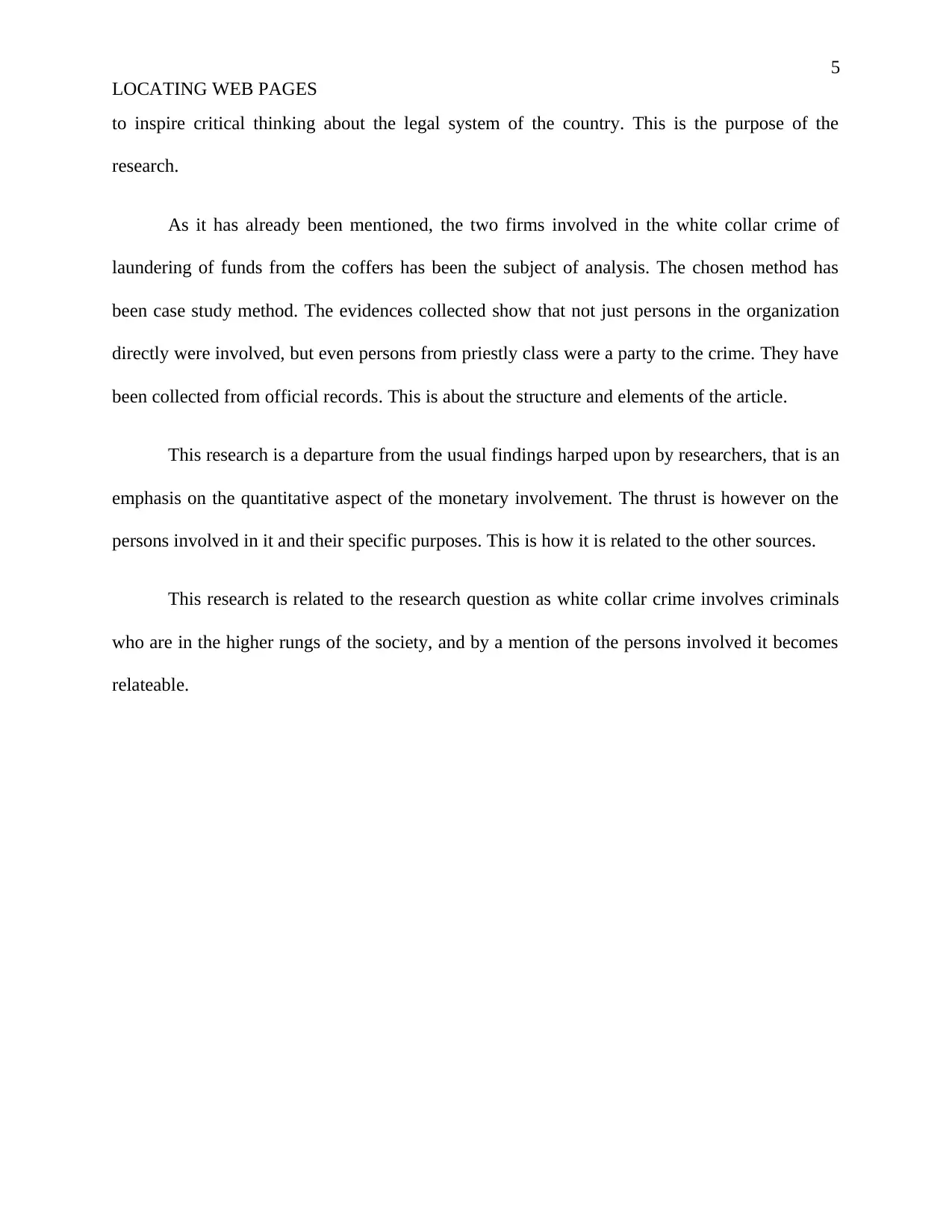
5
LOCATING WEB PAGES
to inspire critical thinking about the legal system of the country. This is the purpose of the
research.
As it has already been mentioned, the two firms involved in the white collar crime of
laundering of funds from the coffers has been the subject of analysis. The chosen method has
been case study method. The evidences collected show that not just persons in the organization
directly were involved, but even persons from priestly class were a party to the crime. They have
been collected from official records. This is about the structure and elements of the article.
This research is a departure from the usual findings harped upon by researchers, that is an
emphasis on the quantitative aspect of the monetary involvement. The thrust is however on the
persons involved in it and their specific purposes. This is how it is related to the other sources.
This research is related to the research question as white collar crime involves criminals
who are in the higher rungs of the society, and by a mention of the persons involved it becomes
relateable.
LOCATING WEB PAGES
to inspire critical thinking about the legal system of the country. This is the purpose of the
research.
As it has already been mentioned, the two firms involved in the white collar crime of
laundering of funds from the coffers has been the subject of analysis. The chosen method has
been case study method. The evidences collected show that not just persons in the organization
directly were involved, but even persons from priestly class were a party to the crime. They have
been collected from official records. This is about the structure and elements of the article.
This research is a departure from the usual findings harped upon by researchers, that is an
emphasis on the quantitative aspect of the monetary involvement. The thrust is however on the
persons involved in it and their specific purposes. This is how it is related to the other sources.
This research is related to the research question as white collar crime involves criminals
who are in the higher rungs of the society, and by a mention of the persons involved it becomes
relateable.
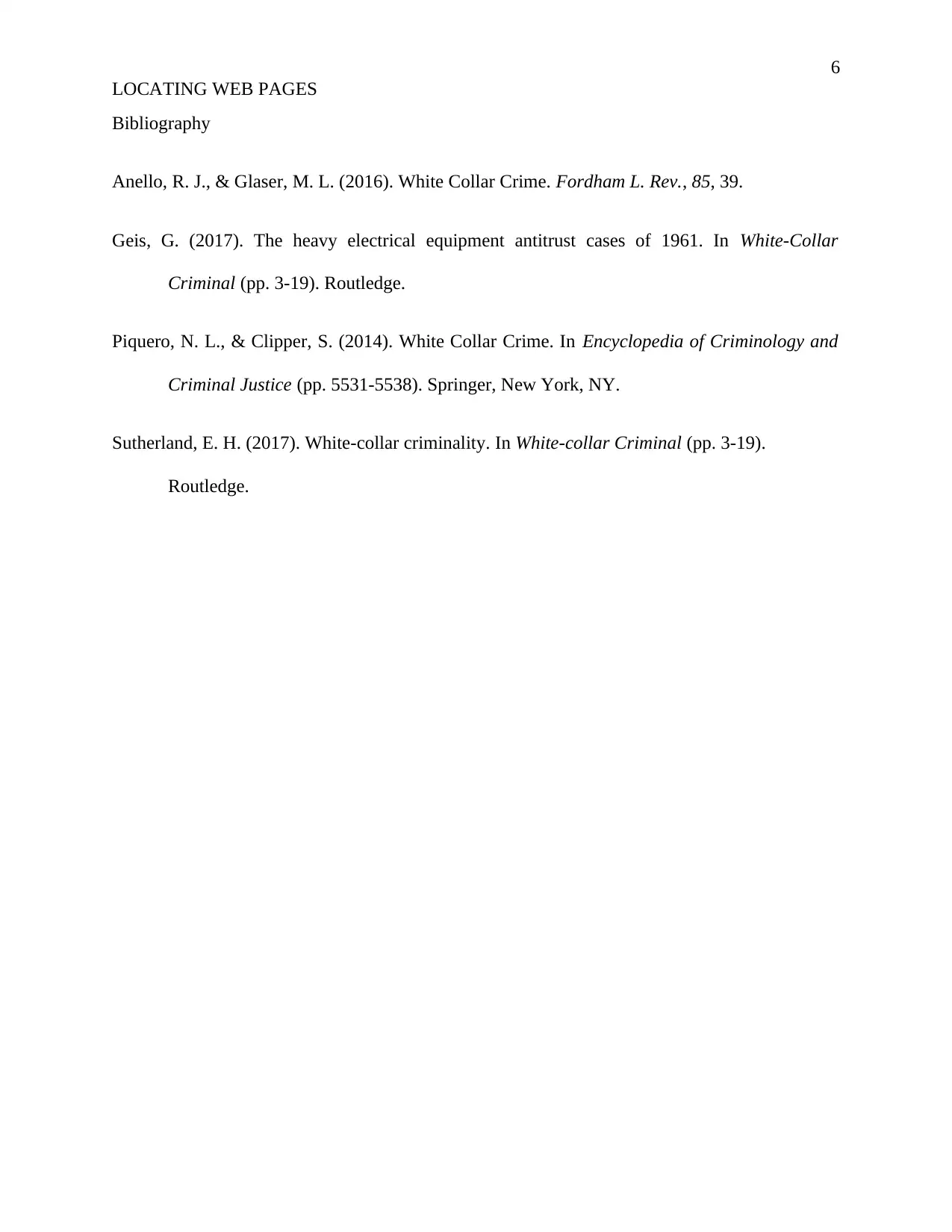
6
LOCATING WEB PAGES
Bibliography
Anello, R. J., & Glaser, M. L. (2016). White Collar Crime. Fordham L. Rev., 85, 39.
Geis, G. (2017). The heavy electrical equipment antitrust cases of 1961. In White-Collar
Criminal (pp. 3-19). Routledge.
Piquero, N. L., & Clipper, S. (2014). White Collar Crime. In Encyclopedia of Criminology and
Criminal Justice (pp. 5531-5538). Springer, New York, NY.
Sutherland, E. H. (2017). White-collar criminality. In White-collar Criminal (pp. 3-19).
Routledge.
LOCATING WEB PAGES
Bibliography
Anello, R. J., & Glaser, M. L. (2016). White Collar Crime. Fordham L. Rev., 85, 39.
Geis, G. (2017). The heavy electrical equipment antitrust cases of 1961. In White-Collar
Criminal (pp. 3-19). Routledge.
Piquero, N. L., & Clipper, S. (2014). White Collar Crime. In Encyclopedia of Criminology and
Criminal Justice (pp. 5531-5538). Springer, New York, NY.
Sutherland, E. H. (2017). White-collar criminality. In White-collar Criminal (pp. 3-19).
Routledge.
1 out of 6
Your All-in-One AI-Powered Toolkit for Academic Success.
+13062052269
info@desklib.com
Available 24*7 on WhatsApp / Email
![[object Object]](/_next/static/media/star-bottom.7253800d.svg)
Unlock your academic potential
© 2024 | Zucol Services PVT LTD | All rights reserved.